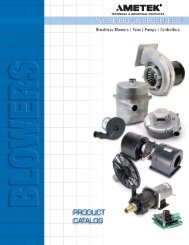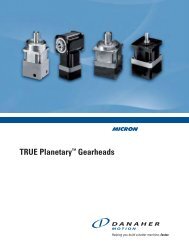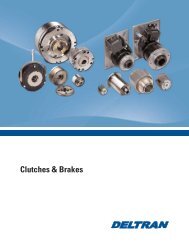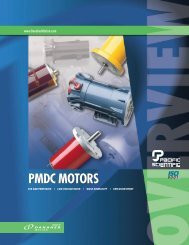Profile Rail Linear Guides
Profile Rail Linear Guides
Profile Rail Linear Guides
You also want an ePaper? Increase the reach of your titles
YUMPU automatically turns print PDFs into web optimized ePapers that Google loves.
<strong>Linear</strong> Motion. Optimized.<br />
<strong>Profile</strong> <strong>Rail</strong> <strong>Linear</strong> <strong>Guides</strong><br />
Calculating the Minimum Required Dynamic Load Rating, C min<br />
The load / life equation above can be rewritten to calculate<br />
the minimum required dynamic load rating which should<br />
be selected for a given applied load and minimum required<br />
travel life :<br />
C min = P(L m / L r) 1 / n<br />
Where :<br />
C min = minimum required dynamic load rating<br />
P = applied load<br />
L m = minimum required travel life<br />
L r = rated travel life<br />
n = 3 for ball guides, 10/3 for roller guides<br />
Note : Check that the applied load, P does not exceed the<br />
dynamic load limit.<br />
Dynamic Load Limit<br />
The dynamic load limit, is the maximum load which should<br />
be applied to the carriage / pillowblock. In some cases,<br />
the dynamic load capacity equals the dynamic load rating.<br />
In others, a limit shown as a percentage of the dynamic<br />
load rating is the maximum load which should be applied.<br />
A dynamic load limit less than the dynamic load rating<br />
does not derate the life of the guide.<br />
Static Capacities<br />
The static capacities are the maximum loads that should<br />
be applied to the bearing while there is no relative motion<br />
between the rolling elements and the raceways. The<br />
value C 0 is the static load capacity for a radial load acting<br />
orthogonal to the axis of travel. The values M OL and M OQ<br />
are the static roll, pitch, and yaw moment capacities.<br />
It is important to analyze the application so that shock<br />
loads do not exceed these capacities. Exceeding these<br />
capacities may permanently deform the rolling elements<br />
and raceways. This type of damage will be realized by an<br />
increase in friction, noise, and vibration, as well as by an<br />
increase in clearance between the carriage and the rail.<br />
For systems experiencing repetitive shock loading less than the static<br />
load capacities, the bearing life should be determined by means of<br />
fatigue calculations.<br />
102<br />
www.thomsonlinear.com











